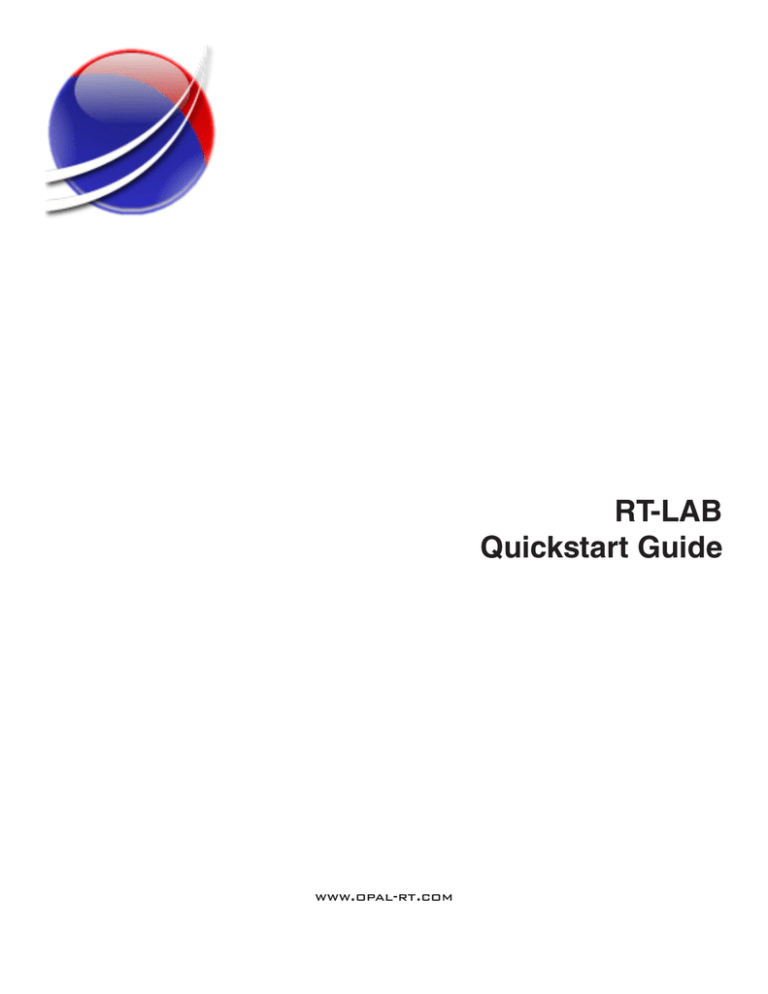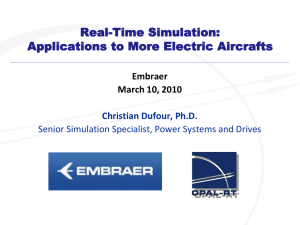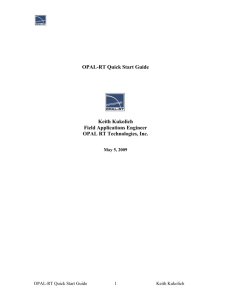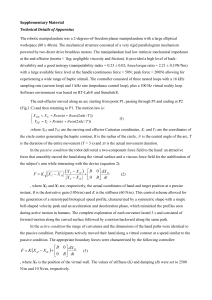
RT-LAB
Quickstart Guide
www.opal-rt.com
CONTENTS
ABOUT RT-LAB...................................................................................................................... 4
INTRODUCTION..................................................................................................................... 5
SOFTWARE REQUIREMENTS........................................................................................... 5
HARDWARE REQUIREMENTS.......................................................................................... 5
GETTING STARTED............................................................................................................ 6
OPEN RT-LAB...................................................................................................................... 6
License Server Setup............................................................................................ 7
THE WELCOME SCREEN.................................................................................................. 8
MAIN RT-LAB WINDOW...................................................................................................... 8
TREE STRUCTURE ICONS...................................................................................................................... 8
USING THE TOOLBAR........................................................................................................ 9
BASIC SETUP................................................................................................................... 10
Create a New Target Node.................................................................................. 10
Create a New Project with Model....................................................................... 10
Build the model. .................................................................................................. 10
Assign Subsystems to targets.............................................................................. 11
Load and Execute the model. ............................................................................... 11
Open and execute the console............................................................................. 12
Reset the Model.................................................................................................. 12
UNDERSTANDING RTDEMO1 CHARACTERISTICS....................................................... 13
OpComm Block.................................................................................................... 13
Subsystems.......................................................................................................... 13
USING SIGNALS AND PARAMETERS................................................................................ 14
Parameters Control .......................................................................................... 14
Probe Control Panel ........................................................................................ 15
DATA ACQUISITION TRIGGERING......................................................................................................... 15
ACQUISITION AND TRANSMISSION PARAMETERS............................................................................ 16
3
RT-LAB Quickstart Guide — Opal-RT Technologies
ABOUT RT-LAB
RT-LAB is a real-time simulation platform for high-fidelity plant simulation, control system prototyping,
and embedded data acquisition and control. Its unique distributed processing capability allows you to
quickly convert your Simulink™ or Systembuild™ models to high-speed, real-time simulations, over
one or more target PC processors.
HOW RT-LAB WORKS
RT-LAB easily integrates Simulink or SystemBuild
models in real-time simulations over one or more PC
processors, particularly for Hardware-in-the-Loop (HIL)
applications. It runs on a networked PC configuration
consisting of a Command (or Host) Station, Target
Node(s), Communication Links (real-time and
Ethernet), and I/O boards.
COMMAND STATION
TARGET NODES
TCP/IP
Host Computer
Real-time Link
COMMAND STATION: A Windows or RedHat PC, on which the RT-LAB software is installed, that
serves as the development system and user interface. It allows users to prepare the model for
distributed real-time execution, control the compilation and execution, and interact with the simulation
at run-time.
TARGET NODE: A PC or cluster of PCs where the simulation runs. For real-time simulation, this
requires a Real-Time Operating System (RTOS) such as QNX or RedHat Real-Time Linux. The
Command Station communicates with Target Node(s) using Ethernet, and the Target Node(s)
communicate with each other using real-time data links such as IEEE 1394 (Firewire at 800 Mbits/s
or PCI Express Dolphin Communication fabric at 20 Gbits/s). For Hardware-in-the-Loop simulations,
Target Nodes connect to the real world through I/O boards (analog and/or digital) and record data at
high speed on their local hard drives, if required.
Each target node can contain one or two processor chips that are compatible with Intel or x86
standards and with shared-memory communications. Each processor can then contain a one, two, four
or six processor core.
Target System: Includes several target computers
Target Computer:
Includes several processor nodes
RT-LAB Quickstart Guide — Opal-RT Technologies
4
INTRODUCTION
Now that you have successfully installed your RT-LAB software following the instructions provided in
the RT-LAB Installation Guide (C:\OPAL-RT\RT-LAB10.x.x\help\pdf\ RT-LAB_IG), you will need to be
up and running quickly. This Quickstart Guide is intended to guide you through the process of setting
up your simulation, using rtdemo1 as the model; it is not intended to be used for detailed training or
advanced use. If you require more detailed or advanced procedures, consult either the User Manual or
the Cheat Sheets provided in the Help Files.
Software updates are available from the OPAL-RT website at http://www.opal-rt.com/support/
downloads. Clicking on the Software name and version will display the MATLAB (and other
applicable third party software) versions supported by the latest OPAL-RT software update.
If you encounter any difficulties not resolved through this document, please contact Opal-RT Technical
Support:
The Opal-RT Team
www.opal-rt.com/support/support-request
Tel: +1-514-935-2323 (8:30am to 5:30pm EST/DST)
Toll free: 1-877-935-2323
SOFTWARE REQUIREMENTS
• MATLAB R2006b and higher
• Windows XP and higher
HARDWARE REQUIREMENTS
• Opal-RT simulator
• Dedicated processor target (PC))
5
RT-LAB Quickstart Guide — Opal-RT Technologies
GETTING STARTED
Before you begin using RT-LAB, you must obtain your software license. Follow these simple
instructions:
1. Open your Web browser and go to the OPAL-RT website www.opal-rt.com
2. Click on Support and scroll down to Licenses, then over and
click on License Activation.
3. The website now displays the Permanent License Activation
window.
4. Fill in all the fields and click Submit. You will receive your
software license via email within 1 business day.
OPEN RT-LAB
Once you have installed RT-LAB, there is an icon displayed in the taskbar (lower right-hand corner of
the Windows screen). Simply double click the RT-Lab icon (shown) to open RT-LAB.
RT-LAB Quickstart Guide — Opal-RT Technologies
6
License Server Setup
Now that you have your software license, you must load it in the software:
1. Save the license file (from the email received from Technical Support) to the OPAL-RT directory
(ex.: C:\OPAL-RT\LicServer)
2. Open Windows Explorer and locate the license server file (ex.: C:\OPAL-RT\LicServer)
3. Double click on the LMTools file. In the LMTools
window, click on the Config Services tab
4. Click on Browse next to the “Path to the license
file” field and select the path to the license file (it
should look like this: “C:\OPAL-RT\LicServer\
Opallmd_DEMO_Opal-RT_F6E1_23-dec-2010.
lic”.
5. Click on the “Start/Stop/Reread” tab
6. Click on Stop Server and wait until server stops, then click on Start Server (to ensure that license
is properly loaded).
Your license is now activated and fully operational. You can close the LMTOOLS window and proceed
to use RT-LAB
Firewalls and antivirus software can affect the installation process; you may need to “Allow”
each controller function individually, as popup windows appear.
7
RT-LAB Quickstart Guide — Opal-RT Technologies
THE WELCOME SCREEN
The first time you open RT-LAB, the first screen is the welcome screen The screen displays 3 icons:
Overview, Tutorials and What’s New.
Icon
Description
Overview provides access to the RT-LAB user manual
Tutorials provides access to 3 different tutorial subjects: “Create a new project using a template model”, “Add
an existing model to a project” and “Six steps to Real-Time”
What’s New provides links to the Opal-RT website and to various trade articles and press releases.
The Workbench icon (top right hand of the screen) closes the Welcome page and displays the RT-LAB main
page. Clicking on this minimizes the Welcome toolbar to the lower right-hand portion of the RT-LAB screen.
MAIN RT-LAB WINDOW
The main RT-LAB window allows you to manage all aspects of your simulation from within a simple
directory tree structure.
Remember that you can click on the Help menu at any time to open the “Cheat Sheets” (task
oriented instructions) option, that can guide you through this process.
Tree Structure Icons
Icon
Description
,
Indicates that the target (circled platform letter) is set as a development node
, ,
Indicates the target’s platform (Q, Qnx; R, Redhat, W, Windows)
Indicates that the target is not responding, not running.
Help files and “Cheat Sheets” are available by clicking on the Help menu. Installation and user
guides can be found in the Opal-RT directory created when the software was installed (C:\
OPAL-RT\RT-LAB10.x.x\help\pdf)
RT-LAB Quickstart Guide — Opal-RT Technologies
8
USING THE TOOLBAR
The main RT-LAB screen provides a convenient toolbar that lets you perform functions with a simple
click. Here is a brief description of the available buttons:
Icon
9
Name
Description
New
Provides access to New Project, New Target, New Model and Other windows
Save
Saves any changes made to the project, model or target.
Build
Builds the model
Assign
Assigns the model to a target
Load
Loads the model and prepares it for execution
Execute
Executes the model
Pause
Pauses the model execution
Reset
Resets the model (stops any current execution)
Take Snapshot
Captures model states at current point and allows future simulations to start from that
point
Matlab (Rxx)
Opens Matlab (if more than one version is installed, they will be listed in a drop-down
menu to open a specific version)
Run Python script
Records actions to be used as an automatic script written in Python (ex.: repetitive
actions can be recorded and performed automatically by the script). See the Help Files
and “Cheat Sheets” for details.
Parameters Control
Opens the Parameters Control window (see page 14) to configure model parameters
Probe Control
Opens the Probe Control window (see page 15) to configure data acquisition parameters
Monitoring Viewer
Opens the monitoring viewer to display processor activities
Scopeview
Opens Scopeview to display and analyze waveforms
RT-LAB Quickstart Guide — Opal-RT Technologies
BASIC SETUP
Create a New Target Node
The first step is to create a new target node:
-- Click on the New button
and select New Target.
-- Enter a name and the specific IP address for the
target (all targets are shipped with a label affixed to the
housing with the default IP address. See your network
administrator to obtain a different IP address.)
-- Click on Ping to ensure that the target is available and
click “Finish” when ping is complete. The New Target
window closes and the target now appears in the lefthand directory structure
-- Select the development node:
right click on the target name and
select the “Set as development
node1” option. The model will be
built on this target node.
-- It is always a good idea to ensure
that the target node runs the
correct version of RT-LAB: simply
right click on the target name,
select Install and then select RT-LAB
Create a New Project with Model
Now, create a new project2 (in this example, using sample model “rtdemo1”):
• Click on the New button
and select New Project to open
the new project wizard.
• Enter a project name (ex.:DocTest) then click Next.
• Browse the template directory to select the model to add to the
project: open the Basic folder and select rtdemo1 (Simulink).
• Click Finish to create the new RT-LAB project in the project
explorer.
Build the model.
• Select the model in the project explorer. Click the build
button on the toolbar to start the compilation.
1: The development node is the target node on which the model will be built and executed.
2: A project is simply the framework that will contain all the models required for the simulation.
RT-LAB Quickstart Guide — Opal-RT Technologies
10
Assign Subsystems to targets
• Open the Assignation tab
• Assign a target node to the model subsystem(s), if a target other than the default development
node is desired.
Load and Execute the model
This transfers and runs the model on the specified target. Select the model in the project explorer and
click on the load button
Pause mode:
on the toolbar. The simulation is transferring to the target, which will be in
• Execute the model by clicking on the execute button
target.
. The simulation is now running on the
NOTE: the highlighted yellow text
indicates
that this model was generated by RT-LAB, which means that this is a running model. When
the model is generated (played) in Simulink, this notice does not appear, which means that
the model is running offline.
11
RT-LAB Quickstart Guide — Opal-RT Technologies
Open and execute the console
Open the generated console to display the simulation results:
• In the project explorer, expand the tree below the model name.
• Double click on the console name (subsystem name beginning
with SC). MATLAB opens and displays the generated console.
• Then click on the play button (inside Simulink) to start the console.
The console is now receiving and sending data to the simulation.
To view the simulation results on an oscilloscope, simply
double click the desired scope block in Simulink
Reset the Model
Stop the simulation and reset the model running on the target.
• Click on the reset button
on the toolbar to stop the simulation on the target.
RT-LAB Quickstart Guide — Opal-RT Technologies
12
UNDERSTANDING RTDEMO1 CHARACTERISTICS
OpComm Block
The rtdemo1 model used throughout this guide contains basic Simulink blocks and a critical custom
block - OpComm. Opal-RT has designed the OpComm block to enable communication between the
Command Station and Target(s) in a distributed simulation.
Each subsystem must contain its own OpComm block, as shown in the image below.
Subsystems
Models contain top level subsystems; master (SM), slave (SS) and console (SC) subsystems for
computations. All inputs to top-level subsystems must first go through an OpComm block before they
can be used by RT-LAB.
In the computation subsystems (SM or SS):
• One OpComm receives real-time-synchronized from other computation subsystems
• One OpComm receives signals asynchronously from the console subsystem
In the console subsystem (SC subsystem):
• One or more OpComm blocks may be inserted to receive signals from other target nodes (in the
case of multi-node systems)
• Acquisition groups3 can be defined for each OpComm blocks. .
3: RT-LAB enables you to set different acquisition groups that group can include many parameters, including the number of signals per frame
to receive, decimation factor, etc. These parameters can be defined separately for each signal using the Probe Control Panel.
13
RT-LAB Quickstart Guide — Opal-RT Technologies
USING SIGNALS AND PARAMETERS
Signals, in Simulink, are the values exchanged between the various blocks. RT-LAB’s SC subsystem
lets you send and receive signals from your model by wiring those signals to the SC subsystem, which
can then be displayed.
Parameters are values that are internal to a block. These values are accessible from the block’s mask,
displayed by double-clicking on the block in Simulink. RT-LAB allows you to modify certain parameters
while the model is running.
Use the RT-LAB main Parameters Control and Probe Control panels to adjust model parameters and
tune your view of the running simulation.
Parameters Control
The Parameters Control panel
allows you to select model parameters and change their values. You
can also use variables to define parameters, allowing you to use the same parameter in many parts of
the model and change its value in only one place.
• Select the desired parameters in the tree on the left
• Click on Add to add the parameter to the table. The parameters can now be edited in the
“Parameters Table”, in the right-hand portion of the window.
RT-LAB Quickstart Guide — Opal-RT Technologies
14
Probe Control Panel
The Probe Control Panel
lets you control acquisition and transmission of signals from the real-time
simulation to the user interface. Changes to Probe Control settings will not affect model execution.
Data acquisition triggering
Trig signal name:
sets the name of the signal to be
triggered.
Trig by value:
specifies the value that must be
reached by the trigger signal to
trigger acquisition.
Trig by signal:
specifies a triggering signal instead
of a constant value
Condition:
condition to be satisfied so that the
acquisition system is triggered. The
different types of condition are:
Write to file:
•
Rising or falling edge
•
Rising edge (the threshold is
crossed on a positive slope, that
is from below)
•
Falling edge (the threshold is crossed on a negative slope, that is from
above)
•
Trigger signal >= trigger level
•
Trigger signal <= trigger level.
saves acquisition group signals on the target node’s hard drive rather than
sending them to the Windows NT Console on the host computer. Signals are
saved in MATFILE version 4, using the name supplied in the FileName field.
Repetetive sampling: enables you to choose repetitive (automated) sampling or non-repetitive (manual
control) sampling. If you choose non-repetitive, the Re-arm button enables you to
manually re-arm data acquisition.
15
RT-LAB Quickstart Guide — Opal-RT Technologies
Acquisition and transmission parameters
Dynamically sets a trigger on the acquisition group (that are applied to OpComm blocks in the sc_
subsystem). Data will be acquired only when the specified signal is triggered. The trigger is defined
using the following fields. Click on Signals to open the Dynamic Signal Selection window and configure
the Acquisition Group. The following settings determine how much data will be gathered before it is
sent to the command station.
Decimation factor: determines the data acquisition frequency on the computation node
Max number of
determines the size of the acquisition window per signal (number of data points
samples per signal: gathered in buffer before sending
Duration: determines the acquisition duration, in milliseconds
Decimation Factor: 1
Decimation Factor: 2
With a decimation factor of 1 (or a timestep of 1 ms), you are able to capture all simulation data,
providing a better overview. With a decimation factor of 2, there is a risk of missing parts or all of a
range of data, as shown above.
These settings may require repeated adjustments to obtain optimal results, particularly when
NS/s: 1
Decimation factor of 2 with NS/s: 2
using synchronized execution modes: The total number of data points is equal to the number of samples per signal x the number of signals
RT-LAB Quickstart Guide — Opal-RT Technologies
16
NOTES
NOTES
CONTACT
Opal-RT Corporate Headquarters
1751 Richardson, Suite 2525
Montréal, Québec, Canada
H3K 1G6
Tel.: 514-935-2323
Toll free: 1-877-935-2323
Note:
While every effort has been made to ensure
accuracy in this publication, no responsibility can
be accepted for errors or omissions. Data may
change, as well as legislation, and you are strongly
advised to obtain copies of the most recently
issued regulations, standards, and guidelines.
This publication is not intended to form the basis
of a contract.
Technical Services
www.opal-rt.com/support
QS10-29197-RT1
09/2010
© Opal-RT Technologies Inc.
MATLAB, Simulink and Real-Time Workshop are trademarks of The Mathworks, Inc. LabVIEW, MATRIXx, SystemBuild and AutoCode are trademarks of National Instruments, Inc.
QNX is a trademark of QNX Software Systems Ltd. FireWire is a trademark of Apple Corporation, Inc.
RedHawk is a trademark of Concurrent Corp. All other brand and product names are trademarks, registered trademarks or service marks of their respective holders. All rights
reserved.





